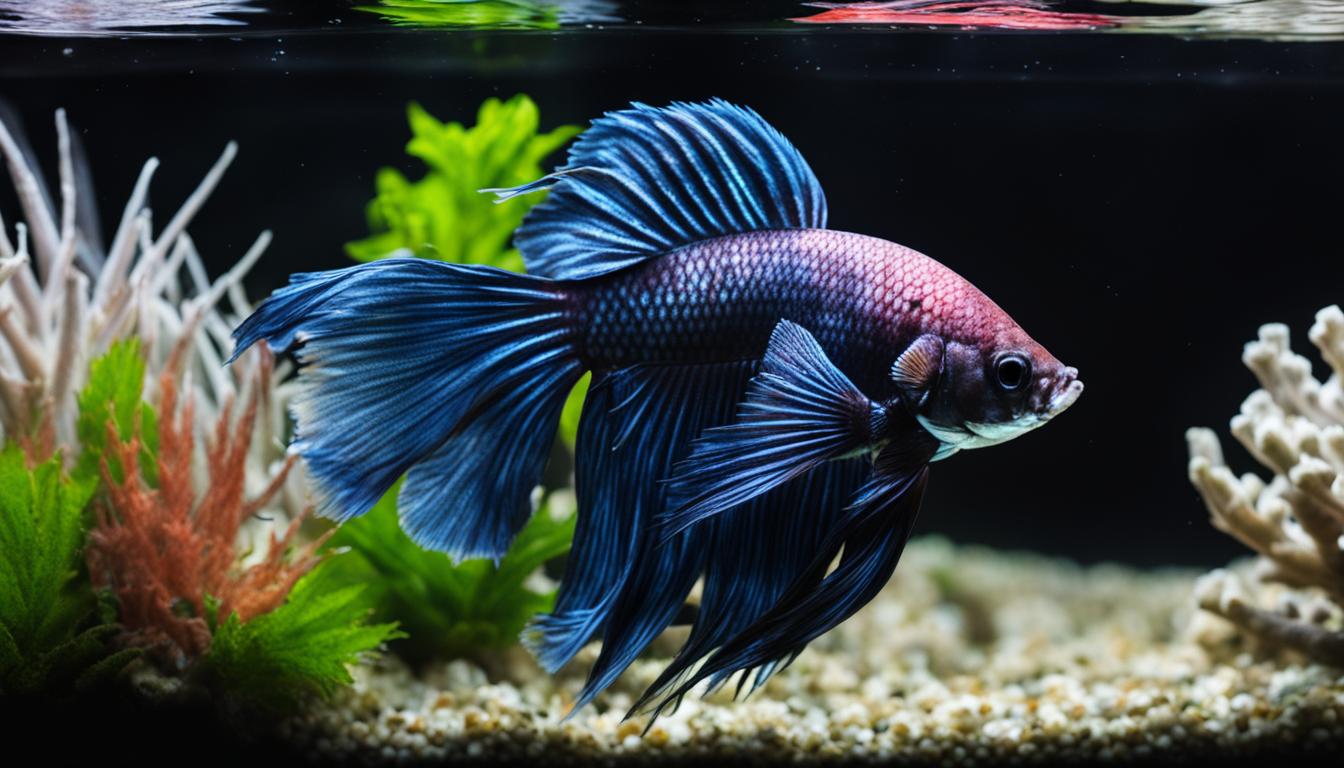Last Updated on 2 years by admin
As a betta fish owner, it’s important to understand the common and sometimes serious condition of dropsy. Dropsy is typically a symptom of an underlying issue, which can be caused by a variety of factors such as poor water conditions, infections, or dietary deficiencies. It’s crucial to address dropsy in a timely and efficient manner to prevent further complications and ensure the best possible outcome for your beloved betta fish.
Key Takeaways:
- Dropsy is a serious and common condition in betta fish that requires prompt attention and care
- Effective treatment of dropsy requires addressing underlying issues such as poor water quality, infections, and dietary deficiencies
- Proper diagnosis and treatment recommendations from a veterinarian are crucial for your betta fish’s recovery
- A multi-faceted approach, including water quality maintenance, medication, dietary adjustments, and supportive care, can help your betta fish recover from dropsy
- Monitoring progress and making necessary adjustments is important for the successful treatment of dropsy in betta fish
Understanding Dropsy in Betta Fish
Dropsy, also known as edema, is a common and serious condition that can affect betta fish. It is a symptom, rather than a disease itself, and is characterized by a buildup of fluid in the fish’s body.
There are several potential causes of dropsy, including bacterial infections, poor water quality, and inadequate diet. In many cases, dropsy is indicative of an underlying health issue and requires prompt attention and care to prevent further complications.
Some of the symptoms to look out for when diagnosing dropsy in betta fish include:
- Bulging eyes
- Swollen belly
- Clamped fins
- Lethargy
- Loss of appetite
- Rapid breathing
Effective treatments for dropsy in betta fish involve a multi-faceted approach that addresses the underlying causes of the condition. In the following sections, we will explore the steps you can take to properly care for your betta fish and help them recover from dropsy.

Possible Causes of Dropsy
As previously mentioned, dropsy can be caused by a variety of factors, including bacterial infections, poor water quality, and inadequate diet. Identifying the underlying cause of the condition is essential for effectively treating dropsy in betta fish.
| Cause of Dropsy | Symptoms |
|---|---|
| Bacterial Infection | Red or bleeding areas on the body, ulcers or sores, loss of appetite, lethargy |
| Poor Water Quality | Cloudy or foul-smelling water, high levels of ammonia or nitrites, sudden changes in water temperature or pH |
| Inadequate Diet | Weight loss, lethargy, dull coloration, lack of appetite |
It is important to note that dropsy may also be a symptom of other underlying health issues, such as parasites or tumors. Consulting with a veterinarian can help ensure an accurate diagnosis and proper treatment plan.
“Identifying the underlying cause of the condition is essential for effectively treating dropsy in betta fish.”
Immediate Care for Betta Fish with Dropsy
If you suspect your betta fish has dropsy, it is important to take immediate action to provide relief and prevent further complications. Here are some tips for managing dropsy in betta fish:
- Isolate your betta fish: Move your betta fish to a separate tank or container to reduce stress and prevent the spread of disease. Make sure the quarantine tank is clean and has the appropriate water parameters.
- Adjust water temperature and quality: Betta fish require warm and clean water to thrive. Keep the water temperature around 78°F and perform regular water changes to maintain good water quality.
- Use aquarium salt: Adding aquarium salt can help reduce swelling and prevent infection. Follow the instructions on the package for proper dosage and duration of treatment.
- Provide supportive care: Betta fish with dropsy may become weak and lethargic. Offer easy-to-digest foods such as boiled peas or brine shrimp, and reduce the water flow to create a calmer environment.
These successful remedies for betta fish suffering from dropsy can help reduce discomfort and boost their immune system.
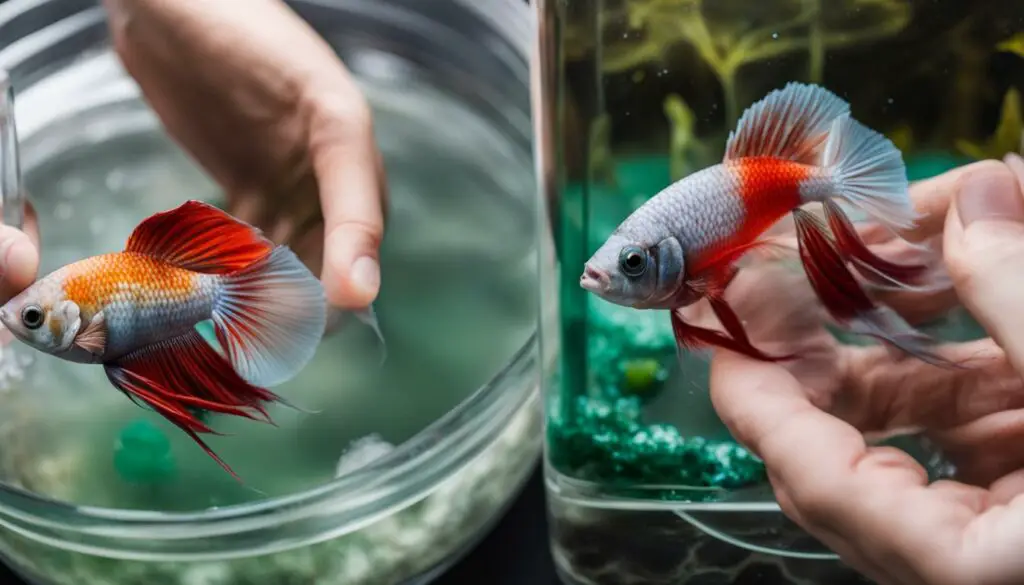
Water Quality and Maintenance
One of the most critical aspects of treating betta fish with dropsy is maintaining excellent water quality. High levels of toxins and poor water conditions can exacerbate the condition, making recovery more difficult.
Regular water changes are key to keeping your aquarium clean and safe for your fish. Aim for at least a 25% water change each week, using a siphon to remove any debris and uneaten food from the substrate. Test the water regularly to ensure the pH, ammonia, nitrite, and nitrate levels are within acceptable ranges.
Natural Remedies for Betta Fish Dropsy
Some natural remedies can help improve water quality and alleviate the symptoms of dropsy. Adding Indian almond leaves (IAL) to the aquarium can help reduce stress levels and enhance water quality. IAL has antimicrobial and anti-inflammatory properties, along with tannins that help to soften and acidify the water, creating a more natural environment for your fish.
Another natural remedy worth considering is aquarium salt. Aquarium salt can help to detoxify the water, reduce swelling, and improve gill function. However, it is essential to use the right amount of salt, as too much can cause additional stress and damage to your fish.
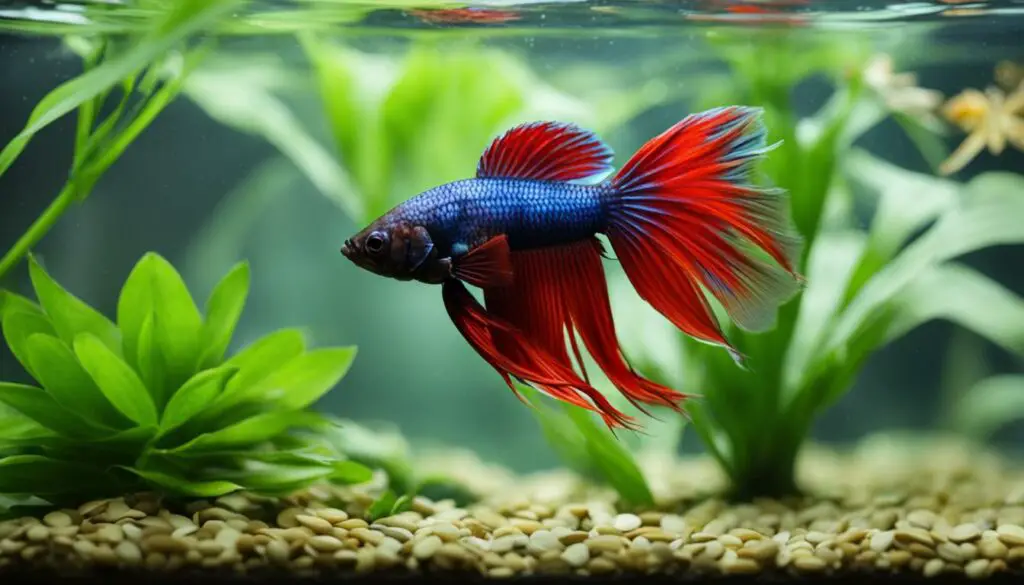
| Natural Remedy | Benefits |
|---|---|
| Indian almond leaves (IAL) | Reduces stress levels and enhances water quality, antimicrobial and anti-inflammatory properties, creates a more natural environment |
| Aquarium salt | Detoxifies water, reduces swelling, and improves gill function |
Holistic Approach for Treating Betta Fish with Dropsy
In addition to natural remedies, taking a holistic approach to treating betta fish with dropsy can help improve overall health and well-being. Ensuring your fish has a balanced and nutritious diet and reducing any potential sources of stress can go a long way in promoting recovery.
Adding live plants to the aquarium can provide additional oxygen and help to absorb any excess nutrients and toxins in the water. Additionally, providing hiding places and stimulating environments can help reduce stress levels and promote natural behaviors.
By maintaining excellent water quality, utilizing natural remedies, and taking a holistic approach, you can help your betta fish recover from dropsy and thrive once again.
Medications for Dropsy Treatment
If dropsy persists despite natural remedies and routine water changes, medication may be necessary to aid in the recovery process. These medications can include:
| Medication Type | Details |
|---|---|
| Antibiotics | Maracyn and Kanamycin are common antibiotics used to treat bacterial infections that are often associated with dropsy. These medications can be added directly to the water, but be sure to follow the dosage instructions carefully. |
| Epsom Salt | Adding a small amount of Epsom salt to the water can help relieve fluid buildup in the fish. Be cautious not to overdose, as it can lead to further health problems. |
| Metronidazole | This medication is used to target parasitic infections that may be causing dropsy. It can be added to the water or given orally, but it can be harmful to other aquatic pets, so quarantine the affected betta fish. |
It is important to note that not all medications are safe for betta fish and should only be used as directed by a veterinarian. In addition, overmedicating can cause more harm than good, so it is important to follow dosage recommendations carefully.
If you are unsure about administering medication or if symptoms worsen, consult with a veterinarian who specializes in aquatic animals.
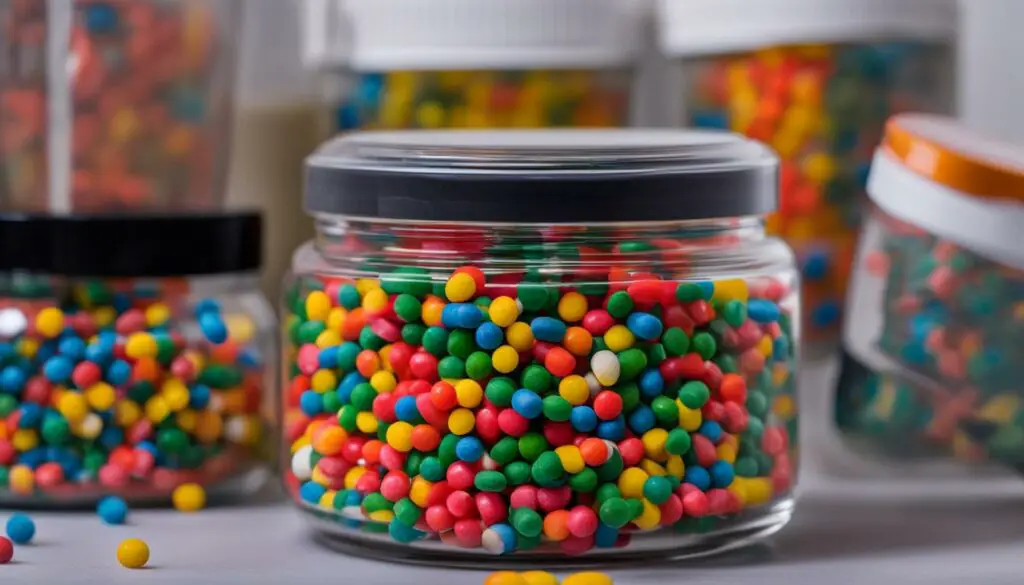
Adjusting Diet and Nutrition
Providing your betta fish with a well-balanced and nutritious diet can greatly aid in the recovery process from dropsy. Here are some effective ways to adjust their diet:
- Feed your betta fish small, frequent meals throughout the day. This can help prevent overeating and reduce stress.
- Include high-quality protein sources in their diet, such as live or frozen brine shrimp or bloodworms.
- Incorporate fresh vegetables and fruits into their meals, such as cucumber or small pieces of apple.
- Avoid feeding your betta fish dried or processed foods, as they can be high in preservatives and low in nutritional value.
It is important to note that overfeeding your betta fish can lead to digestive issues and exacerbate dropsy symptoms. Use a feeding schedule and do not feed them more than what they can consume in 2-3 minutes.
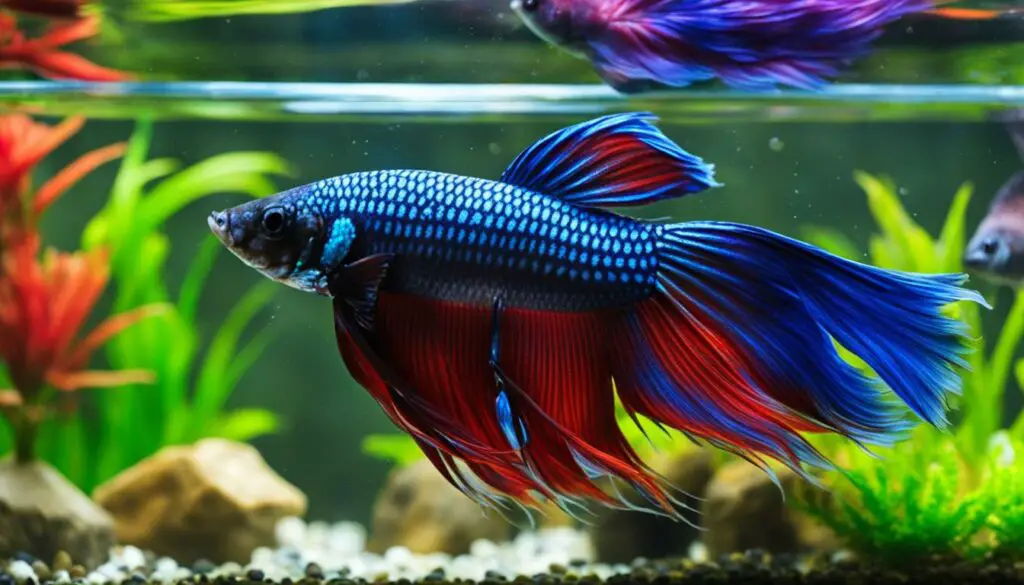
In addition to adjusting their diet, you can consider adding supplements to support their immune system. Supplements such as garlic or vitamin C can help boost their resistance to disease and promote healing.
It is crucial to ensure the water quality and cleanliness are properly maintained, as poor water conditions can compromise your betta fish’s immune system and hinder their recovery. See section 4 for more information on maintaining water quality.
Isolation and Quarantine
If you suspect that your betta fish has dropsy, it is important to take immediate action to prevent the spread of disease to other fish in your tank. Isolating your sick betta fish can also help provide a more controlled environment for treatment.
To set up a quarantine tank, you will need a separate tank with suitable water parameters and a filter. It is important to thoroughly clean all equipment before use to avoid any contamination. The quarantine tank should not be smaller than 5 gallons.
Before placing your betta fish in the quarantine tank, observe the water temperature, pH levels, and ammonia and nitrate readings to make sure they are similar to the main tank. Use a water conditioner to remove any chlorine or chloramines from the water.
In the quarantine tank, provide hiding places and objects for your betta fish to reduce stress during the treatment. You can add live plants or a suitable decoration to mimic the natural environment of the fish.
| Tip: | Use a separate net and avoid cross-contamination by not using equipment from the main tank. |
|---|
While your betta fish is in quarantine, continue the treatment plan for dropsy as prescribed by your veterinarian. Monitor your fish’s progress and note any changes in behavior, appetite, or physical appearance.
If your betta fish shows signs of improvement, you can slowly reintroduce them to the main tank. Do not rush the process and make sure to acclimate them to the new environment over a period of several days.
Isolating and quarantining your betta fish is an important step in treating dropsy and preventing the spread of disease. Always seek the guidance of a veterinarian for proper diagnosis and treatment recommendations.

Supportive Care and Stress Reduction
Supportive care and stress reduction are crucial elements in treating betta fish with dropsy. Providing a calm and healthy environment can greatly aid in the recovery process.
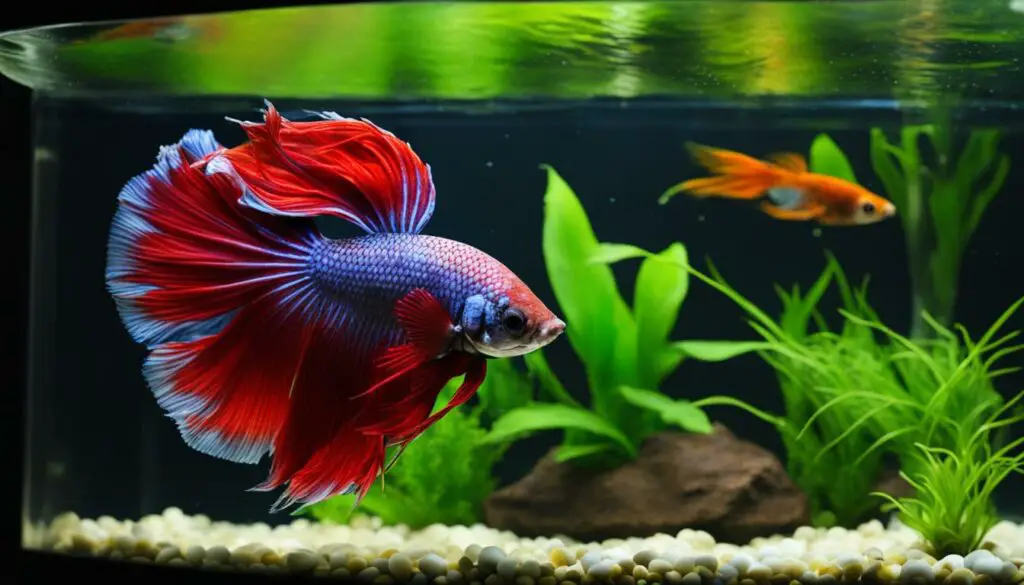
One way to reduce stress is to avoid overcrowding the tank. Betta fish are solitary creatures, and it is important to provide them with enough space to swim and explore. A tank size of at least 5 gallons is recommended for a single betta fish, with appropriate filtration and equipment to maintain water quality.
Another way to reduce stress is to provide hiding places and enrichment. Adding plants, caves, and other decorations can create a more natural and stimulating environment for your betta fish.
Additionally, maintaining consistent water parameters and avoiding sudden changes can help reduce stress. Regular monitoring and testing of water quality can help ensure the optimal environment for your betta fish.
Lastly, providing a balanced and nutritious diet is important for the overall health and recovery of your betta fish. High-quality pellets, frozen or live foods, and supplements can help meet their nutritional needs and strengthen their immune system.
Monitoring and Follow-up Care
After following the steps outlined in the previous sections, it is important to continuously monitor your betta fish’s progress and make any necessary adjustments. Here are some tips for managing dropsy in betta fish:
- Observe your fish for any changes in behavior or symptoms.
- Keep track of water parameters and perform regular water changes to maintain optimal quality.
- Adjust the diet and nutrition of your fish as needed.
- Consider using natural remedies to supplement medication.
- Isolate or quarantine your fish if necessary.
- Provide a stress-free environment with proper tank decorations and hiding places.
- Consult with a veterinarian if symptoms persist or worsen.
Successful remedies for betta fish suffering from dropsy require consistency and patience. Your betta fish may take some time to fully recover and may require ongoing care even after symptoms have subsided. By remaining vigilant and attentive to your fish’s needs, you can help ensure their continued health and happiness.
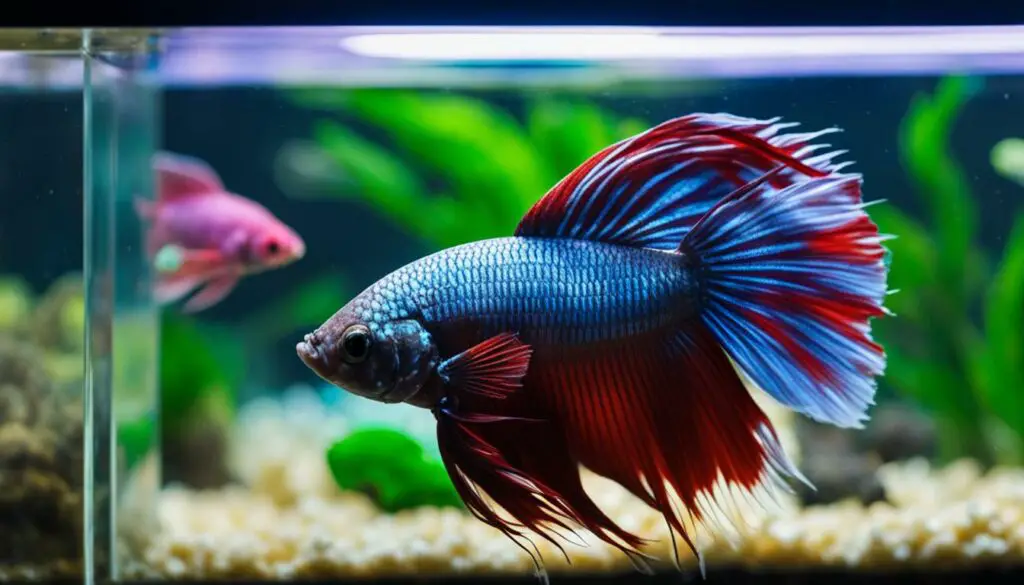
Example Monitoring Log:
| Date | Water Parameters | Fish Behavior and Symptoms | Notes |
|---|---|---|---|
| MM/DD/YYYY | pH: 7.0, Ammonia: 0ppm, Nitrite: 0ppm, Nitrate: 10ppm | Appears more active and alert, fins less clamped | Performed 30% water change, added natural remedy |
| MM/DD/YYYY | pH: 7.2, Ammonia: 0ppm, Nitrite: 0ppm, Nitrate: 20ppm | Not eating, fins clamped, bloated appearance | Increased medication dosage, isolated fish in quarantine tank |
| MM/DD/YYYY | pH: 7.4, Ammonia: 0ppm, Nitrite: 0ppm, Nitrate: 10ppm | Improved appetite, less bloated, swimming more frequently | Performed 50% water change, added new decorations for stimulation |
By keeping a monitoring log like this, you can easily track and analyze your fish’s progress over time. This can help you identify patterns, adjust your treatment plan, and determine when additional veterinary care may be necessary.
Conclusion
In conclusion, dropsy is a serious and common condition in betta fish that requires prompt attention and care. By understanding the symptoms, causes, and treatment options, you can properly care for your aquatic friend and aid in their recovery. Remember to maintain proper water quality through regular changes and suitable parameters, provide a balanced diet, and administer medication and isolation when necessary. Additionally, providing supportive care and reducing stress can greatly aid in the healing process.
It is crucial to monitor your betta fish’s progress and make any necessary adjustments to the treatment plan. Seeking veterinary care when needed is also important for proper diagnosis and treatment recommendations. By following these effective steps and providing diligent care, you can help your betta fish recover from dropsy and lead a healthy and happy life.
FAQ
What is dropsy in betta fish?
Dropsy is a common and serious condition in betta fish that is characterized by bloating and swelling. It is often caused by organ failure or infection.
How do I know if my betta fish has dropsy?
Common symptoms of dropsy in betta fish include bloated appearance, raised scales, pineconing, loss of appetite, lethargy, and difficulty swimming.
Can dropsy in betta fish be cured?
While dropsy is a serious condition, with prompt and proper treatment, there is a chance for recovery. It is important to start treatment as soon as possible.
What can I do to help prevent dropsy in my betta fish?
Maintaining proper water quality, providing a balanced diet, and minimizing stress can help prevent the development of dropsy in betta fish.
What should I do if my betta fish has dropsy?
If your betta fish has dropsy, it is important to isolate them, maintain clean water conditions, and consult with a veterinarian for proper treatment options.
Can dropsy be treated with medication?
In some cases, medication may be necessary to treat dropsy in betta fish. Consult with a veterinarian to determine the best course of action.
How long does it take for a betta fish to recover from dropsy?
The recovery time for betta fish with dropsy can vary depending on the severity of the condition and the effectiveness of the treatment. It may take several weeks or longer for full recovery.
What should I feed my betta fish with dropsy?
Providing a nutritious diet is essential for the recovery of betta fish with dropsy. Offer high-quality pellets, frozen or live foods, and avoid overfeeding.
Can dropsy in betta fish be contagious?
Dropsy itself is not contagious, but the underlying causes or infections may be. It is important to quarantine and monitor any new fish before introducing them to your aquarium.
Should I seek veterinary care for my betta fish with dropsy?
Yes, it is recommended to consult with a veterinarian experienced in fish care to properly diagnose and treat dropsy in betta fish.

